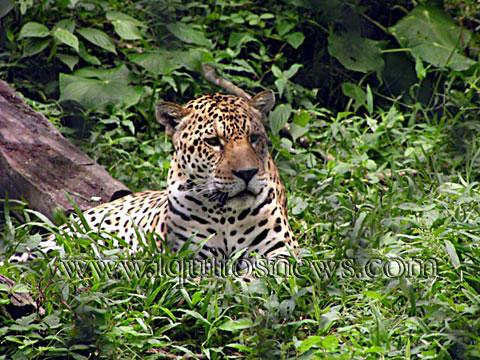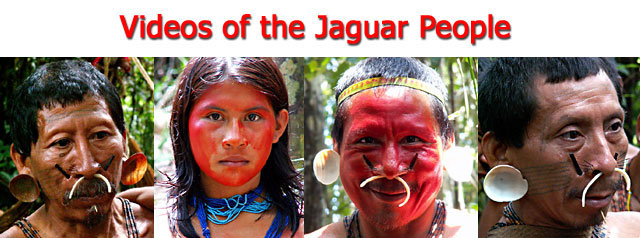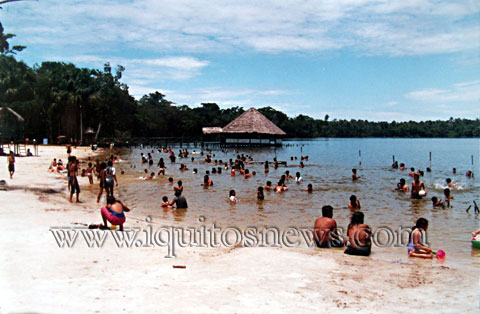ccording to a local indigenous legend, long ago there
existed a mysterious island that was located in the middle of beautiful lake.
This haunted island was inhabited by evil spirits and many brightly colored
macaws. Whenever something bad happened at the nearby town, the macaws would start squawking and the island would move
with powerful earthquakes caused by the evil spirits.
Being terrified by the earthquakes, the natives asked a priest to
perform an exorcism to rid them of the evil spirits who occupied the island.
The priest performed an exorcism and afterwards he tossed a crucifix into the lake. The
normally calm waters of the lake unexpectedly became agitated and the island shook as the
terrified villagers looked on. The people all ran away, screaming “Cristo Cocha” (which
translates to Christ’s lake) and at the same time a huge black snake emerged
from the lake and began swimming away. As the giant snake swam away, the
villagers could hear the snake crying with a whistle-like screech as if injured.
The exorcism was a success and the departure of the snake represented the
removal the evil spirits from the island in the lake. With the passing of time, the name
"Christo Cocha" became Quistococha. According to this native American legend,
today this lake is the enchanting lagoon that exists in the Quistococha Zoo.
In 1979,
Quistococha first opened as the Quistococha Zoological Park. Quistococha is a National Tourist Park under the
Peruvian National Tourist Park System that was named Quistococha after the
legend of the original natives. Quistococha Zoological Park occupies
an area of more than 369 hectares and the Quistococha lagoon is approximately 60 hectares,
while the developed zoo area is about 8 hectares. Quistococha is located just 7
kilometers from Iquitos on the Iquitos-Nauta highway. The zoo houses many
species of animals that are indigenous to the Amazon Basin, including
alligators, tapirs, rodents, pumas, jaguars, monkeys, snakes, giant otters, and a
magnificent collection of macaws and various other birds that are native to the
Amazon. There is even a group of wild monkeys that live in the trees that surrounding the lake.
In addition to the animals, there is a botanical garden with many labeled
specimens of trees and a collection of medicinal plants.
 Inside
the Quistococha Zoological Park there are several restaurants that serve
delicious local dishes. Quistococha also includes a picturesque beach called Tunchi Playa (Ghost Beach).
From the dock area, you can rent canoes and paddle out to the other side of the lake
and explore the rich wildlife surrounding the lake. In addition, there is
a hiking trail that leads to the Itaya River which is located just a few kilometers
from the park. A visit to Quistococha is an unforgettable experience and allows
new visitors to become familiar with the Amazon and its wildlife before they
embark on their tours in a rain forest lodge or travel deeper into the Amazon
rain forest. Inside
the Quistococha Zoological Park there are several restaurants that serve
delicious local dishes. Quistococha also includes a picturesque beach called Tunchi Playa (Ghost Beach).
From the dock area, you can rent canoes and paddle out to the other side of the lake
and explore the rich wildlife surrounding the lake. In addition, there is
a hiking trail that leads to the Itaya River which is located just a few kilometers
from the park. A visit to Quistococha is an unforgettable experience and allows
new visitors to become familiar with the Amazon and its wildlife before they
embark on their tours in a rain forest lodge or travel deeper into the Amazon
rain forest.
One could complete a quick visit to the
Quistococha Zoo in as little as an hour. But to really get to know the zoo,
it is recommended to allow at least 3-4 hours, especially if you want to learn
about the local legends and participate in other activates in addition to seeing
the zoo area. Optional activities include walking on the rain forest trail (insect repellent
recommended), enjoying a
refresco (soft drink) by the beautiful beach (Tunchi Playa), swimming, and enjoying
the local cuisine from one of several restaurants located inside the park. To fish on the
60 hectare lake, it is recommended to arrive early in the morning for best
success fishing and to avoid the high temperatures that occur during the middle
of the day.
To get to Quistococha, you can arrive by minibus (combi) departing
from the city center of Iquitos near Alfonso Ugarte and Prospero Streets or from the corner of Bermudez
and Moore just off the Plaza 28 de Julio (near Colegio San Agustin). Combis
only cost two soles (less than a dollar) while a personal
motocarro should cost no more than twelve soles (less than four dollars).
To return to Iquitos, one can travel by combi or use one of the taxis
that are usually found waiting in front of the park entrance.

|


 Inside
the Quistococha Zoological Park there are several restaurants that serve
delicious local dishes. Quistococha also includes a picturesque beach called Tunchi Playa (Ghost Beach).
From the dock area, you can rent canoes and paddle out to the other side of the lake
and explore the rich wildlife surrounding the lake. In addition, there is
a hiking trail that leads to the Itaya River which is located just a few kilometers
from the park. A visit to Quistococha is an unforgettable experience and allows
new visitors to become familiar with the Amazon and its wildlife before they
embark on their tours in a rain forest lodge or travel deeper into the Amazon
rain forest.
Inside
the Quistococha Zoological Park there are several restaurants that serve
delicious local dishes. Quistococha also includes a picturesque beach called Tunchi Playa (Ghost Beach).
From the dock area, you can rent canoes and paddle out to the other side of the lake
and explore the rich wildlife surrounding the lake. In addition, there is
a hiking trail that leads to the Itaya River which is located just a few kilometers
from the park. A visit to Quistococha is an unforgettable experience and allows
new visitors to become familiar with the Amazon and its wildlife before they
embark on their tours in a rain forest lodge or travel deeper into the Amazon
rain forest.
